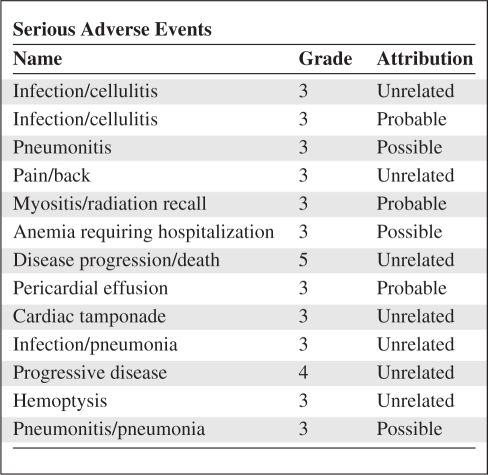Abstract
Background.
Gemcitabine and docetaxel have a broad spectrum of clinical activity in patients with carcinoma. The Sarcoma Alliance for Research Through Collaboration conducted a phase II trial of gemcitabine in combination with docetaxel in children and adults with recurrent Ewing sarcoma (EWS), osteosarcoma (OS), or unresectable or recurrent chondrosarcoma. The primary objective was to determine the objective response rate using Response Evaluation Criteria in Solid Tumors (RECIST).
Methods.
Gemcitabine (675 mg/m2 i.v. over 90 minutes on days 1 and 8) was administered in combination with docetaxel (75 mg/m2 i.v. over 1 hour on day 8) every 21 days. All patients received filgrastim or pegfilgrastim. A Bayesian formulation was used to determine the probability of achieving the target response rate for each subtype—0.35 for EWS and OS or 0.20 for chondrosarcoma. If the probability of achieving the target response rate was <0.05, the combination was considered inactive. Toxicity was graded according to Common Terminology Criteria for Adverse Events (CTCAE), version 3.0.
Results.
Fifty-three eligible patients were enrolled in the three subtype groups—OS (n = 14), EWS (n = 14), and chondrosarcoma (n = 25). Toxicities included neutropenia, thrombocytopenia, fatigue, dyspnea, bronchospasm, edema, neuropathy, and liver function abnormalities. Dose modification for toxicity was required for eight patients during cycle 1 and 16 patients in subsequent cycles. Seven patients withdrew from therapy as a result of toxicity. No complete responses were observed. Partial responses were observed in OS (n = 1), EWS (n = 2), and chondrosarcoma (n = 2) patients.
Conclusion.
Gemcitabine in combination with docetaxel was associated with a probability of reaching the target 35% response rate of <5% in OS patients and 5.6% in EWS patients; the probability of reaching a 20% response rate in chondrosarcoma patients was 14%.
Discussion.
The Bayesian formulation permitted estimation of the probability of achieving the target response rate for each subtype after each response evaluation. By allowing multiple looks at the data, this design stopped the trial after considering the probability of achieving the target response rate and accrual rate. Because this design did not specify a rule for declaring the treatment as “active,” a direct comparison with a standard two-stage phase II design is not appropriate. The decision to close the EWS and chondrosarcoma subtype arms was based, in part, on slow accrual and was supported by the low probability of achieving the target response rate. The rate of enrollment, rather than the statistical design, had a significant effect on the trial duration.
ClinicalTrials.gov Identifier: NCT00073983 Sponsor(s): Sarcoma Alliance Through Collaboration
Principal Investigator(s): Elizabeth Fox, M.D. IRB Approved: Yes
Serious Adverse Events



